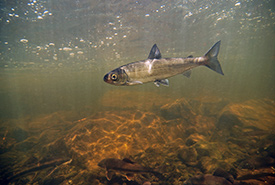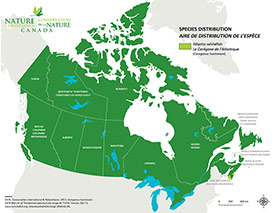
Atlantic whitefish (Photo by Bob Semple)
Atlantic whitefish
Size and appearance
This silvery-sided fish, with its blueish-green back, can be confused with the more common lake whitefish. In addition to their unique life cycle, Atlantic whitefish differ from lake whitefish by their relatively smaller scales. Atlantic whitefish also have well-developed teeth and are considered the most ancient species of the whitefish family in North America.
Range
Atlantic whitefish is an endangered species unique to Canada that exists only in Nova Scotia. Historical records show that it may have once been found throughout southwestern Nova Scotia. Today, its range has shrunk further, and the last wild population of Atlantic whitefish on the planet is found only in the Petite Rivière watershed.
Migration
Historically, the Atlantic whitefish was anadromous, meaning it spawned in fresh water but lived most of its life at sea. But as dams were built in the 1800s to power mills, its passage to the sea was cut off.
Threats
Atlantic whitefish may very well be one of the most endangered species in all of Canada. In addition to dams and barriers that have blocked the species’ migration, smallmouth bass and chain pickerel have been introduced to the lakes where it still lives. While smallmouth bass and chain pickerel are native to Canada, they are not native to these lakes and have added a new predator that is impacting the small population of Atlantic whitefish.
Status
Atlantic whitefish is assessed as critically endangered by the International Union for Conservation of Nature Red List of Threatened Species and listed as endangered under Canada’s Species at Risk Act. In 1984, it was the first fish in Canada to be assessed as endangered by the Committee on the Status of Endangered Wildlife in Canada.
Conservation to the rescue
In 2004, the Bluenose Coastal Action Foundation (now called Coastal Action) launched the Atlantic Whitefish Recovery Project to raise public awareness of the species and its dwindling population. The organization continues to work with the federal Department of Fisheries and Oceans (DFO) to stabilize what is left of the population in the Petite Rivière watershed.
An amended recovery strategy and action plan was released in 2018 by DFO, with the goal of stabilizing the current population of Atlantic whitefish in Nova Scotia and expanding its current range. As part of the strategy, the Petite Rivière watershed has been designated as a critical habitat area for the species.
There was some good news for this species. In 2018, Halifax’s Dalhousie University took possession of nearly two dozen newly hatched Atlantic whitefish and these fish are now thriving. Raising a captive population is an important conservation strategy to prevent this species from becoming extinct.
Protecting vital habitat
The Nature Conservancy of Canada’s (NCC’s) Atlantic Region has developed a freshwater conservation blueprint for the region and is exploring options to support the species’ recovery. This blueprint will help identify where threats to the Atlantic whitefish occur and help assist in planning for its recovery.
We still have an opportunity to protect this unique Canadian species for future generations, but we need to move quickly. The fate of Atlantic whitefish will be decided by the conservation actions we take today.





